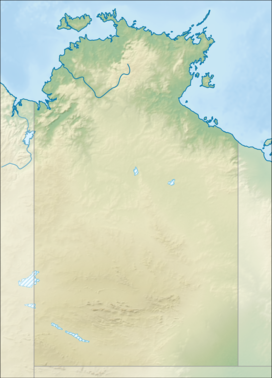| Kelly Hills | |
|---|---|
| Yankunytjatjara: Aputjilpi | |
 | |
| Highest point | |
| Elevation | 870 m (2,850 ft) |
| Coordinates | 25°51′54″S 131°26′52″E / 25.86500°S 131.44778°E / -25.86500; 131.44778 |
| Geography | |
| Country | Australia |
| Territory | Northern Territory |
| Locality | Petermann |
| Range coordinates | 25°49′S 131°25′E / 25.817°S 131.417°E / -25.817; 131.417 |
| Geology | |
| Rock age | Paleoproterozoic |
| Rock type(s) | gneiss, quartzite |
The Kelly Hills (Yankunytjatjara: Aputjilpi) are a mountain range at the southern end of the Northern Territory of Australia. It is located in the locality of Petermann directly north of the Musgrave Ranges and about 50 kilometres (31 mi) northeast of Amaṯa in South Australia. Its highest point is about 870 metres (2,850 ft) above sea level. Mount Robert, at the eastern end of the range, is about 796 metres (2,612 ft) above sea level. The area is known as Aputjilpinya in the native Yankunytjatjara language. It forms part of an important Mala Dreaming track that runs between Uluṟu and Ulkiya.
There are a few soakages located within the hills. One of them, Puntitjara, was recorded by several early White explorers travelling through the Kelly Hills. The South Australian government's North-West Prospecting Expedition, led by Lawrence Wells, was brought there by an Aboriginal guide in 1903; one of the expedition's prospectors, Herbert Basedow, recorded the name as "Punndijarrinna" and reported that it was a good source of water. Basedow returned to Puntitjara in June 1926 on another expedition, this one led by Donald Mackay. According to Mackay, they found it dry and covered with a layer of sand. The anthropologist Ted Strehlow visited Puntitjara in August 1936, but founded it covered by mud.
References
- "Kelly Hills". Geoscience Australia. Australian Government, Department of Resources, Energy and Tourism. Archived from the original on 27 June 2013. Retrieved 19 April 2013.
- "Place Names Register Extract for "Kelly Hills"". NT Place Names Register. Northern Territory Government. Retrieved 8 October 2019.
- "Mount Robert". Northern Territory Place Names Register. Northern Territory Government. Retrieved 18 April 2013.
- John Toohey (1980). "Report by the Aboriginal Land Commissioner, Mr Justice Toohey, to the Minister for Aboriginal Affairs and to the Minister for Home Affairs". Uluru (Ayers Rock) National Park and Lake Amadeus/Luritja Land Claim. Canberra: Australian Government Publishing Service. p. 15. ISBN 0-642-046-255.
- Robert Layton (1986). Uluru: an Aboriginal history of Ayers Rock. Australian Institute of Aboriginal Studies. p. 124. ISBN 9780855751616.
- Herbert Basedow (1914). Journal of the Government North-West Expedition. Adelaide: Royal Geographical Society of Australasia. p. 173.
- Donald George Mackay (1929). The Geographical Journal. Adelaide: Royal Geographical Society of Australasia. pp. 258, 261.
- T. G. H. Strehlow (1969). "Mythology of the Centralian Aborigine". Inland Review. 3 (12): 13.
- "Four Months to Cover 1,212 Miles of Desert: Patrol Officer's Tour With Wife; Blacks Warned Away From Civilisation". The Advertiser. Adelaide. 13 January 1937. p. 24.